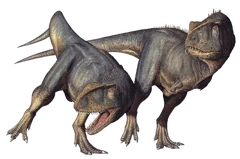| Rugops Temporal range: 95–Late Cretaceous Ma | |
|---|---|

| |
| An artist's rendering of a pair of Rugops primus | |
| Scientific classification | |
| Kingdom: | Animalia |
| Phylum: | Chordata |
| clade: | Dinosauria |
| Order: | Saurischia |
| Suborder: | Theropoda |
| Family: | †Abelisauridae |
| Genus: | †Rugops Sereno et al., 2004 |
| Species: | †R. primus |
| Binomial name | |
| †Rugops primus Sereno et al., 2004 | |
Rugops Primus (meaning “first wrinkle face”) is a genus of medium sized abelisaurid theropod dinosaur, which inhabited what is now Africa approximately 95 million years ago (Cenomanian stage of the Late Cretaceous). The discovery of a Rugops skull in Niger in 2000 was a crucial breakthrough in the understanding of the evolution of theropods in that area, and demonstrates that this landmass was still united with Gondwana at that stage in history.[1][2][3][4]
It was contemporary of the much larger carnivores such as Unnamed Abelisaur, Spinosaurus, Sarcosuchus, Deltadromeus, Carcharodontosaurus and Bahariasaurus. It also has one of the shortest names of any dinosaur along with the Australian ankylosaur Minmi and the scansoriopterygid Yi.[5]
Description[]
At 4-4.5 meters (12-16 ft) long and 1.5 meters (4 feet) high at the hip, Rugops was a midsize carnivore. The skull bore armour or scales, and other bones had many blood vessels, causing Dr. Paul Sereno, who led the team that discovered the fossil, to say, “It’s not the kind of head designed for fighting or bone-crushing”, suggesting that it may have been mostly a scavenger (though this has yet to fully be confirmed). The skull also bears two rows of seven holes each, of unknown purpose, although Sereno has speculated that they may have anchored some kind of crest or horns. Like other abelisaurs, Rugops probably had very short arms. These were probably useless in fighting.[6][7][8]
They may have only been balance tools, items to counterbalance the dinosaur’s head. The type species is R. primus (meaning “first wrinkle-face”). Rugops is believed to be an abelisaurid, related to other abelisaurids like Majungasaurus and Carnotaurus. The discovery of the related genus Chenanisaurus indicates African abelisaurids such as Rugops may have been distinct from other abelisaurids in Gondwana.
Paleoecology[]
The discovery of Rugops's skull in Niger in 2000 was a crucial breakthrough in the understanding of the evolution of theropods in that area, and demonstrates that this landmass was still united with Gondwana at that stage in history. It lived in the same locality and geological time period as Spinosaurus, Carcharodontosaurus, and Deltadromeus. It also lived alongside Paralititan, Ouranosaurus, and other North African Cretaceous dwellers. It likely was able to bring down very small herbivores, but probably just scavenged.[9]
In the media[]
- Rugops appears in the third episode of Monsters Resurrected Biggest Killer Dino, attacking a juvenile Paralititan but inaccurately shown it being lifted by the jaws of Spinosaurus and gobbled up whole. In real life, a 30 feet long Rugops was far too large for Spinosaurus to lift with its 5.5 feet (1.7 meter) long jaws and consume whole. The other one was being chased by the Spinosaurus but was killed like the last one. Then a pack of 5 Rugops took down a Paralititan before having a Spinosaurus attempt to steal the food, but the pack's numbers are so great, the theropods kill and eat the Spinosaurus after it fell on it's side & broke it's tall spines.
- Rugops is featured in Dinosaur King.
- Rugops also appears in BBC's Planet Dinosaur, where it was shown as a natural born scavenger, eating the remains of the dead 8 meters (27 feet) sawfish Onchopristis left by a Spinosaurus.
- Rugops DNA was used in order to help make the Indominus rex in Jurassic World by adding neck armour to it.
- This dinosaur was one of the supporting characters (identified in 2016) in Ricardo Delgado's Age of Reptiles: Ancient Egyptians mini-series.
References[]
- ↑ https://www.dinosaurhome.com/rugops-primus-the-loser-abelisaur-1937.html
- ↑ https://www.sciencesource.com/1836746-rugops-primus-a-prehistoric-era-dinosaur.html
- ↑ https://paulsereno.uchicago.edu/exhibits_casts/african_dinosaurs/rugops/
- ↑ https://www.youtube.com/watch?app=desktop&v=50uEdrQ_mf4
- ↑ https://www.mindat.org/taxon-4966168.html
- ↑ https://eol.org/tr/pages/4532800
- ↑ www.fossilworks.org/cgi-bin/bridge.pl?a=taxonInfo&taxon_no=71395
- ↑ https://a-dinosaur-a-day.com/post/78295631150/rugops-primus/amp
- ↑ https://dinosauriacreatures.com/en/products/rugops-primus